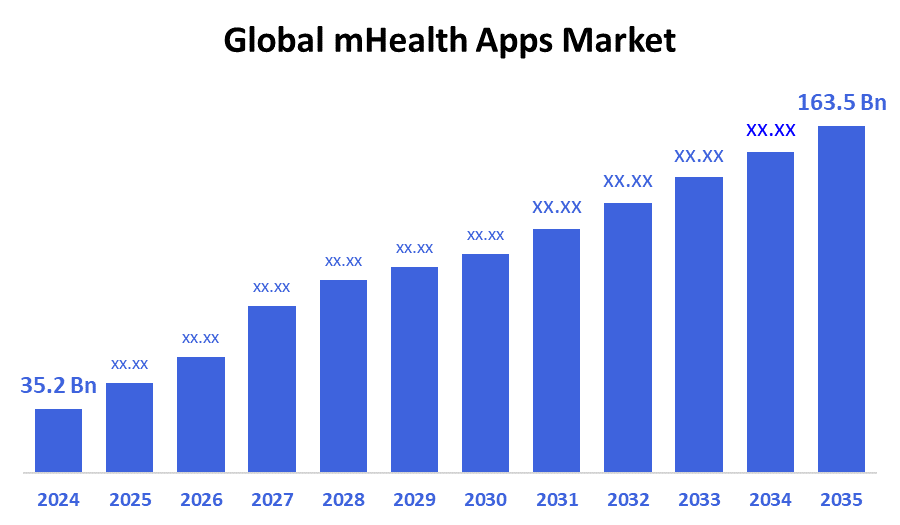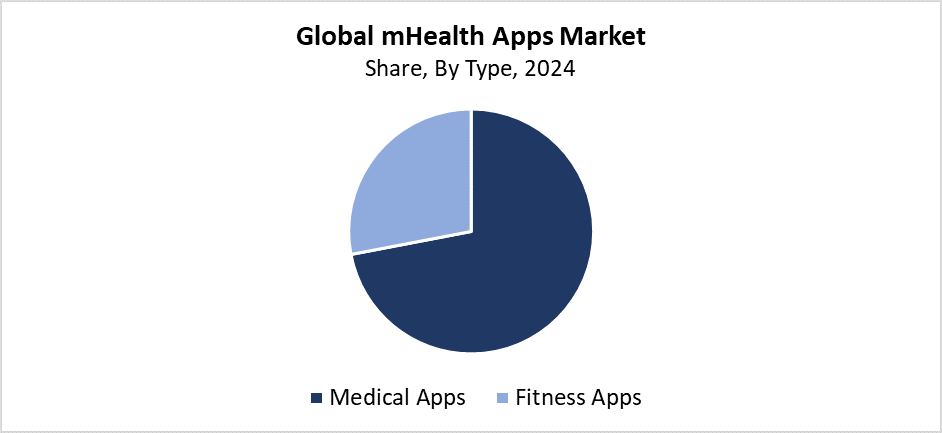Global mHealth Apps Market
Global mHealth Apps Market Size, Share, and COVID-19 Impact Analysis, By Type (Medical Apps, Fitness Apps), By Platform (Android, iOS, Others), and By Region (North America, Europe, Asia-Pacific, Latin America, Middle East, and Africa), Analysis and Forecast 2025-2035
Report Overview
Table of Contents
mHealth Apps Market Summary
The Global mHealth Apps Market Size Was Estimated at USD 35.2 Billion in 2024 and is Projected to Reach USD 163.5 Billion by 2035, Growing at a CAGR of 14.98% from 2025 to 2035. Rising smartphone usage, greater health consciousness, the need for remote healthcare, the treatment of chronic illnesses, fitness tracking, the use of telemedicine, and encouraging government digital health efforts are all driving growth in the mHealth apps market.

Key Regional and Segment-Wise Insights
- In 2024, the mHealth apps market in North America held a 36.2% revenue share, dominating the global market.
- In 2024, the medical apps segment had the highest revenue share of 72.4% and led the market based on type.
- In 2024, the iOS segment had the largest revenue share of 38.4% and led the market based on platform.
Global Market Forecast and Revenue Outlook
- 2024 Market Size: USD 35.2 Billion
- 2035 Projected Market Size: USD 163.5 Billion
- CAGR (2025-2035): 14.98%
- North America: Largest market in 2024
- Asia Pacific: Fastest growing market
The market for mHealth apps represents the digital healthcare sector, which focuses on smartphone applications that support health services. Users access mHealth applications for doctor visits through virtual platforms, and these apps track medications and manage chronic diseases as well as monitor fitness levels while providing instant access to medical information. The fast-growing industry stems from increasing internet penetration and smartphone adoption, as well as rising health awareness and global demand for affordable, accessible healthcare. The rising cases of diabetes, alongside hypertension and cardiovascular diseases, push patients to seek both continuous health monitoring and personalized medical attention. mHealth applications serve as effective solutions for the specified needs of healthcare delivery. The expansion of telemedicine services, along with virtual doctor visits, has driven the rising popularity of mHealth applications among users.
The mHealth apps market experiences a transformation because of advancements in technology. Real-time alerts, personalized health monitoring, and precise diagnostics become achievable through the combination of artificial intelligence (AI) with data analytics, cloud computing, and wearable device integration. Worldwide governments support digital health ecosystems through public education initiatives, regulatory systems, and financial assistance programs. The FDA's digital health guidelines, together with India's Digital Health Mission, serve as initiatives that both encourage innovation and ensure regulatory compliance. These positive steps build confidence among developers while enhancing access to mHealth applications throughout the world.
Type Insights

What Factors Enabled the Medical Apps Segment to Capture a 72.4% Revenue Share in the mHealth Apps Market in 2024?
The medical apps segment led the mHealth apps market by generating the largest revenue share of 72.4% in 2024. Medical apps dominate the market because of growing requirements for apps that support clinical functions, including patient tracking and chronic disease management, along with remote medical services and diagnostic assistance. Both patients and healthcare providers use medical applications extensively because these tools help them improve their care coordination and treatment adherence, and communication. The combination of rising chronic illness rates and the need for convenient healthcare access has driven a substantial increase in mobile app usage. Medical applications maintain their leading position in the global mHealth market because they have improved their effectiveness through AI integration along with EHR management and telemedicine capabilities.
The fitness apps segment within the mHealth Apps Market is anticipated to grow at a significant CAGR during the forecast period. At-home workout popularity, along with individualized fitness plans and increasing health consciousness among consumers, fuel this market expansion. Fitness applications appeal to diverse user groups because they provide goal-setting capabilities and virtual coaching along with activity tracking and wearable device integration. The worldwide rise in lifestyle-related health problems, including obesity and stress, has led people to adopt exercise applications as part of their daily routines. The ongoing expansion of this segment receives support from AI-powered user experience enhancements, together with real-time data analysis.
Platform Insights
What Made the iOS Segment Dominate the mHealth Apps Market with a 38.4% Revenue Share in 2024?
The iOS segment led the mHealth Apps Market in 2024 by securing the highest revenue share at 38.4%. The dominance of iOS users in developed nations with widespread digital health acceptance, particularly North America and Europe, drives this high revenue share. Through its secure and user-friendly platform, iOS supports exceptional fitness and wellness applications. Through HealthKit and Apple Watch integration, users can monitor vital health statistics and fitness targets and manage chronic illness conditions. The spending power of iOS customers enables them to invest more money into high-quality health software and subscription-based services. The combination of robust technology, privacy features, and a loyal user community makes iOS the leading platform for mHealth applications at present.
During the projected time frame, the Android segment of the mHealth Apps Market is anticipated to grow at the fastest CAGR. The rapid expansion is because Android smartphones dominate worldwide usage, especially across developing countries in the Asia Pacific region, Latin America, and Africa. Through its open-source platform, developers can create and launch mHealth apps that address multiple demographic groups due to Android's flexible development process and affordable costs. Android devices offer affordable pricing that enables low- to middle-income consumers to obtain digital healthcare solutions. The market experiences rapid expansion because Android's health integration features, including Google Fit and better data privacy policies, become more attractive to both consumers and developers of health applications.
Region Insights
North America dominated the global mHealth apps market with the largest revenue share of 36.2% during 2024. The region maintains its leadership position through its advanced healthcare infrastructure and its large population of smartphone users, combined with its strong digital health research initiatives. Wearable technology, alongside telemedicine and remote patient monitoring systems, has driven the substantial growth of mHealth app usage. The market experienced faster growth because of government programs that promote EHR integration and mobile health technology support. The region secured its position as a leader because major IT companies and healthcare organizations operate there alongside residents who focus on health.
Asia Pacific mHealth Apps Market Trends
The mHealth apps market across the Asia Pacific is anticipated to grow at the fastest CAGR throughout the forecast period because of rising smartphone penetration, together with expanding internet coverage and increased digital health solution awareness. Mobile health applications serve as an acceptable solution because healthcare services need to become more accessible and affordable in China, as well as India and Southeast Asian countries. The expanding market exists because chronic diseases are becoming more prevalent, and younger people are developing stronger health awareness. The expansion of digital health networks through government initiatives, including India's Ayushman Bharat Digital Mission, creates favorable conditions for market development. The mHealth app market worldwide receives substantial growth from the Asia Pacific because of its large population base and growing health technology investments.
Europe mHealth Apps Market Trends
The European mHealth app market grows significantly because of rising chronic disease rates, together with digital health adoption and preventive healthcare. The European nations, including Germany, the United Kingdom, and France, and the Nordic countries, lead the way through their established healthcare systems, which actively integrate mobile health solutions. Through its regulatory support for digital health, the European Union promotes innovation and builds customer trust by supporting programs such as the European Health Data Space and GDPR data protection measures. The COVID-19 outbreak accelerated telehealth implementation, which boosted the need for wellness applications along with remote patient monitoring. The region's mHealth app effectiveness reaches new heights as digital enterprises join forces with healthcare experts to expand their market reach across different user segments.
Key mhealth Apps Companies:
The following are the leading companies in the mHealth apps market. These companies collectively hold the largest market share and dictate industry trends.
- Apple Inc.
- AirStrip Technologies, Inc.
- Samsung Electronics Co. Ltd.
- Sanofi
- Orange
- Qualcomm Technologies, Inc.
- AstraZeneca
- Abbott
- AT&T
- Johnson & Johnson Services, Inc.
- Google Inc.
- Pfizer Inc.
- Others
Recent Developments
- In November 2024, Omron's home blood pressure monitors with AI-driven atrial fibrillation (AFib) detection were authorized by the FDA De Novo. By analyzing pressure pulse waves during measurement, the IntelliSenseTM AFib algorithm seeks to improve early AFib detection and lower the risk of stroke.
- In September 2024, Apple expanded its line of wearable health technologies with the release of the Apple Watch Series 10, which has sophisticated health monitoring features, including sleep apnea diagnosis and hearing health evaluations.
Market Segment
This study forecasts revenue at global, regional, and country levels from 2020 to 2035. Decision Advisors has segmented the mHealth apps market based on the below-mentioned segments:
Global mHealth Apps Market, By Type
- Medical Apps
- Fitness Apps
Global mHealth Apps Market, By Platform
- Android
- iOS
- Others
Global mHealth Apps Market, By Regional Analysis
- North America
- US
- Canada
- Mexico
- Europe
- Germany
- UK
- France
- Italy
- Spain
- Russia
- Rest of Europe
- Asia Pacific
- China
- Japan
- India
- South Korea
- Australia
- Rest of Asia Pacific
- South America
- Brazil
- Argentina
- Rest of South America
- Middle East & Africa
- UAE
- Saudi Arabia
- Qatar
- South Africa
- Rest of the Middle East & Africa
Check Licence
Choose the plan that fits you best: Single User, Multi-User, or Enterprise solutions tailored for your needs.
We Have You Covered
- 24/7 Analyst Support
- Clients Across the Globe
- Tailored Insights
- Technology Tracking
- Competitive Intelligence
- Custom Research
- Syndicated Market Studies
- Market Overview
- Market Segmentation
- Growth Drivers
- Market Opportunities
- Regulatory Insights
- Innovation & Sustainability
Report Details
| Pages | 240 |
| Delivery | PDF & Excel via Email |
| Language | English |
| Release | Sep 2025 |
| Access | Download from this page |
